Watershed Horizontal Ecological Compensation Policy and Green Ecological City Development: Spatial and Mechanism Assessment
Abstract
:1. Introduction
2. Literature Review and Conceptual Framework
2.1. Ecological Compensation Policy
2.2. Watershed Ecological Compensation Game
2.3. Ecological Compensation and Green Ecological City Development
3. Research Methodology
3.1. Construction of GTFP
3.2. Assessing the Impact of WHEC Policy—DID Method
3.3. Data Sources
4. Results and Discussion
4.1. Descriptive Statistics
4.2. The State of GTFP and its Distribution
4.3. Impact of Environmental Regulations—DID Results
4.4. Mechanism Assessment and Regional Heterogeneity
4.5. Spatial Analysis
4.6. Robustness Test
4.6.1. Parallel Trend Test
4.6.2. PSM–DID
4.6.3. Exclude Other Policies Test
4.6.4. Placebo Test
4.6.5. Surrogate Index Test
5. Conclusions
Author Contributions
Funding
Institutional Review Board Statement
Informed Consent Statement
Data Availability Statement
Conflicts of Interest
References
- Arthington, A.H.; Naiman, R.J.; McClain, M.E.; Nilsson, C. Preserving the biodiversity and ecological services of rivers: New challenges and research opportunities. Freshw. Biol. 2010, 55, 1–16. [Google Scholar] [CrossRef]
- Aruga, K. Economic Instrument and Environmental Problems. In Environmental and Natural Resource Economics; Aruga, K., Ed.; Springer International Publishing: Cham, Switzerland, 2022; pp. 19–58. [Google Scholar] [CrossRef]
- Aryal, K.; Bhatta, L.D.; Thapa, P.S.; Ranabhat, S.; Neupane, N.; Joshi, J.; Shrestha, K.; Shrestha, A.B. Payment for ecosystem services: Could it be sustainable financing mechanism for watershed services in Nepal? Green Financ. 2019, 1, 221–236. [Google Scholar] [CrossRef]
- Blicharska, M.; Hedblom, M.; Josefsson, J.; Widenfalk, O.; Ranius, T.; Öckinger, E.; Widenfalk, L.A. Operationalisation of ecological compensation–Obstacles and ways forward. J. Environ. Manag. 2022, 304, 114277. [Google Scholar] [CrossRef] [PubMed]
- Bruckerhoff, L.A.; Wheeler, K.; Dibble, K.L.; Mihalevich, B.A.; Neilson, B.T.; Wang, J.; Yackulic, C.B.; Schmidt, J.C. Water Storage Decisions and Consumptive Use May Constrain Ecosystem Management under Severe Sustained Drought. JAWRA J. Am. Water Resour. Assoc. 2022, 58, 654–672. [Google Scholar] [CrossRef]
- Cao, H.; Li, M.; Qin, F.; Xu, Y.; Zhang, L.; Zhang, Z. Economic Development, Fiscal Ecological Compensation, and Ecological Environment Quality. Int. J. Environ. Res. Public Health 2022, 19, 4725. [Google Scholar] [CrossRef]
- Chen, C.; He, G.; Lu, Y. Payments for Watershed Ecosystem Services in the Eyes of the Public, China. Sustainability 2022, 14, 9550. [Google Scholar] [CrossRef]
- Cheng, Y.; Wang, Y.; Chen, W.; Wang, Q.; Zhao, G. Does income inequality affect direct and indirect household CO2 emissions? A quantile regression approach. Clean Technol. Environ. Policy 2021, 23, 1199–1213. [Google Scholar] [CrossRef]
- Cheng, Z.; Li, X. Do raising environmental costs promote industrial green growth? A Quasi-natural experiment based on the policy of raising standard sewage charges. J. Clean. Prod. 2022, 343, 131004. [Google Scholar] [CrossRef]
- Cooper, W.W.; Seiford, L.M.; Tone, K. Introduction to Data Envelopment Analysis and Its Uses: With Dea-Solver Software and References; Springer Science & Business Media: Berlin/Heidelberg, Germany, 2006. [Google Scholar]
- Cotler, H.; Cuevas, M.L.; Landa, R.; Frausto, J.M. Environmental Governance in Urban Watersheds: The Role of Civil Society Organizations in Mexico. Sustainability 2022, 14, 988. [Google Scholar] [CrossRef]
- Dallimer, M.; Strange, N. Why socio-political borders and boundaries matter in conservation. Trends Ecol. Evol. 2015, 30, 132–139. [Google Scholar] [CrossRef]
- Eren, F. Does the Asian Property Market Work for Sustainable Urban Developments? Sustainable Cities in Asia; Routledge: Oxfordshire, UK, 2017; pp. 32–47. [Google Scholar] [CrossRef]
- Fu, Y.; Xiong, K.; Zhang, Z. Ecosystem services and ecological compensation of world heritage: A literature review. J. Nat. Conserv. 2021, 60, 125968. [Google Scholar] [CrossRef]
- Tundisi, J.G. Reservoirs: New challenges for ecosystem studies and environmental management. Water Secur. 2018, 4–5, 1–7. [Google Scholar] [CrossRef]
- Guo, S.; Deng, X.; Ran, J.; Ding, X. Spatial and Temporal Patterns of Ecological Connectivity in the Ethnic Areas, Sichuan Province, China. Int. J. Environ. Res. Public Health 2022, 19, 12941. [Google Scholar] [CrossRef] [PubMed]
- Hao, Y.; Zheng, S.; Zhao, M.; Wu, H.; Guo, Y.; Li, Y. Reexamining the relationships among urbanization, industrial structure, and environmental pollution in China—New evidence using the dynamic threshold panel model. Energy Rep. 2020, 6, 28–39. [Google Scholar] [CrossRef]
- Heckman, J.J.; Ichimura, H.; Todd, P.E. Matching as an econometric evaluation estimator: Evidence from evaluating a job training programme. Rev. Econ. Stud. 1997, 64, 605–654. [Google Scholar] [CrossRef]
- Hu, Y.; Cheng, H. Water pollution during China’s industrial transition. Environ. Dev. 2013, 8, 57–73. [Google Scholar] [CrossRef]
- Ji, S.; Ma, S. The effects of industrial pollution on ecosystem service value: A case study in a heavy industrial area, China. Environ. Dev. Sustain. 2022, 24, 6804–6833. [Google Scholar] [CrossRef]
- Jiang, X.; Eaton, S.; Kostka, G. Not at the table but stuck paying the bill: Perceptions of injustice in China’s Xin’anjiang eco-compensation program. J. Environ. Policy Plan. 2022, 24, 581–597. [Google Scholar] [CrossRef]
- Jin, B.; Winemiller, K.O.; Ren, W.; Tickner, D.; Wei, X.; Guo, L.; Li, Q.; Zhang, H.; Pompeu, P.S.; Goichot, M.; et al. Basin-scale approach needed for Yangtze River fisheries restoration. Fish Fish. 2022, 23, 1009–1015. [Google Scholar] [CrossRef]
- Kerr, J. Watershed management: Lessons from common property theory. Int. J. Commons 2007, 1, 89–109. [Google Scholar] [CrossRef]
- Lei, Z.; Huang, L.; Cai, Y. Can environmental tax bring strong porter effect? Evidence from Chinese Listed Companies. Environ. Sci. Pollut. Res. 2022, 29, 32246–32260. [Google Scholar] [CrossRef]
- Li, H.; Lu, J. Can inter-governmental coordination inhibit cross-border illegal water pollution? A test based on cross-border ecological compensation policy. J. Environ. Manag. 2022, 318, 115536. [Google Scholar] [CrossRef]
- Li, J.; Chen, L.; Chen, Y.; He, J. Digital economy, technological innovation, and green economic efficiency—Empirical evidence from 277 cities in China. Manag. Decis. Econ. 2022, 43, 616–629. [Google Scholar] [CrossRef]
- Li, W. Analysis on the Influence of Western Ecological Aesthetics on Environmental Design of China’s “Beautiful Countryside”. J. Environ. Public Health 2022, 2022, 1271825. [Google Scholar] [CrossRef] [PubMed]
- Li, Z.; Pan, Y.; Yang, W.; Ma, J.; Zhou, M. Effects of government subsidies on green technology investment and green marketing coordination of supply chain under the cap-and-trade mechanism. Energy Econ. 2021, 101, 105426. [Google Scholar] [CrossRef]
- Lin, B.; Zhou, Y. Does energy efficiency make sense in China? Based on the perspective of economic growth quality. Sci. Total Environ. 2022, 804, 149895. [Google Scholar] [CrossRef] [PubMed]
- Lin, J.; Zhang, L. Temporal and spatial characteristics of green total factor productivity in energy-intensive industry in China. Environ. Sci. Pollut. Res. 2022. [Google Scholar] [CrossRef]
- Liu, C.; Ma, C.; Xie, R. Structural, innovation and efficiency effects of environmental regulation: Evidence from China’s carbon emissions trading pilot. Environ. Resour. Econ. 2020, 75, 741–768. [Google Scholar] [CrossRef]
- Liu, Y.; Liu, J.; Zhou, Y. Spatio-temporal patterns of rural poverty in China and targeted poverty alleviation strategies. J. Rural. Stud. 2017, 52, 66–75. [Google Scholar] [CrossRef]
- Liu, Y.; Liu, M.; Wang, G.; Zhao, L.; An, P. Effect of Environmental Regulation on High-quality Economic Development in China—An Empirical Analysis Based on Dynamic Spatial Durbin Model. Environ. Sci. Pollut. Res. 2021, 28, 54661–54678. [Google Scholar] [CrossRef] [PubMed]
- Liu, Y.; Liu, Y.; Chen, Y.; Long, H. The process and driving forces of rural hollowing in China under rapid urbanization. J. Geogr. Sci. 2010, 20, 876–888. [Google Scholar] [CrossRef]
- Liu, Y.; Zhou, Y. Reflections on China’s food security and land use policy under rapid urbanization. Land Use Policy 2021, 109, 105699. [Google Scholar] [CrossRef]
- Lu, C.; Wang, B.; Chen, T.; Yang, J. A document analysis of peak carbon emissions and carbon neutrality policies based on a PMC index model in China. Int. J. Environ. Res. Public Health 2022, 19, 9312. [Google Scholar] [CrossRef]
- Lu, S.; Lu, W.; Shao, W.; Xue, Y.; Taghizadeh-Hesary, F. The transboundary ecological compensation construction based on pollution rights: Ways to keep the natural resources sustained. Resour. Policy 2021, 74, 102401. [Google Scholar] [CrossRef]
- Lu, S.; Shang, Y.; Li, W.; Wu, X.; Zhang, H. Basic theories and methods of watershed ecological regulation and control system. J. Water Clim. Chang. 2018, 9, 293–306. [Google Scholar] [CrossRef]
- Ma, N.; Liu, P.; Xiao, Y.; Tang, H.; Zhang, J. Can Green Technological Innovation Reduce Hazardous Air Pollutants?—An Empirical Test Based on 283 Cities in China. Int. J. Environ. Res. Public Health 2022, 19, 1611. [Google Scholar] [CrossRef]
- Miller, S.M.; Upadhyay, M.P. Total factor productivity and the convergence hypothesis. J. Macroecon. 2002, 24, 267–286. [Google Scholar] [CrossRef]
- Nie, X.; Chen, Z.; Wang, H.; Wu, J.; Wu, X.; Lu, B.; Qiu, L.; Li, Y. Is the “pollution haven hypothesis” valid for China’s carbon trading system? A re-examination based on inter-provincial carbon emission transfer. Environ. Sci. Pollut. Res. 2022, 29, 40110–40122. [Google Scholar] [CrossRef]
- Ouyang, X.; Li, Q.; Du, K. How does environmental regulation promote technological innovations in the industrial sector? Evidence from Chinese provincial panel data. Energy Policy 2020, 139, 111310. [Google Scholar] [CrossRef]
- Qian, Y.; Liu, J.; Cheng, Z.; Forrest, J.Y.-L. Does the smart city policy promote the green growth of the urban economy? Evidence from China. Environ. Sci. Pollut. Res. 2021, 28, 66709–66723. [Google Scholar] [CrossRef]
- Ren, S.; Hao, Y.; Wu, H. How does green investment affect environmental pollution? Evidence from China. Environ. Resour. Econ. 2022, 81, 25–51. [Google Scholar] [CrossRef]
- Schofer, E.; Ramirez, F.O.; Meyer, J.W. The societal consequences of higher education. Sociol. Educ. 2021, 94, 1–19. [Google Scholar] [CrossRef]
- Shang, S.; Chen, Z.; Shen, Z.; Shabbir, M.S.; Bokhari, A.; Han, N.; Klemeš, J.J. The effect of cleaner and sustainable sewage fee-to-tax on business innovation. J. Clean. Prod. 2022, 361, 132287. [Google Scholar] [CrossRef]
- Shen, Y.; Yue, S.; Sun, S.; Guo, M. Sustainable total factor productivity growth: The case of China. J. Clean. Prod. 2020, 256, 120727. [Google Scholar] [CrossRef]
- Sheng, J.; Han, X. Practicing policy mobility of payment for ecosystem services through assemblage and performativity: Lessons from China’s Xin’an River Basin Eco-compensation Pilot. Ecol. Econ. 2022, 191, 107234. [Google Scholar] [CrossRef]
- Song, M.; Peng, L.; Shang, Y.; Zhao, X. Green technology progress and total factor productivity of resource-based enterprises: A perspective of technical compensation of environmental regulation. Technol. Forecast. Soc. Chang. 2022, 174, 121276. [Google Scholar] [CrossRef]
- Su, B.; Heshmati, A.; Geng, Y.; Yu, X. A review of the circular economy in China: Moving from rhetoric to implementation. J. Clean. Prod. 2013, 42, 215–227. [Google Scholar] [CrossRef]
- Tang, J.; Gong, J.; Ma, W.; Rahut, D.B. Narrowing urban–rural income gap in China: The role of the targeted poverty alleviation program. Econ. Anal. Policy 2022, 75, 74–90. [Google Scholar] [CrossRef]
- Tian, Y.; Pang, J. The role of internet development on green total-factor productivity—An empirical analysis based on 109 cities in Yangtze River economic belt. J. Clean. Prod. 2022, 378, 134415. [Google Scholar] [CrossRef]
- Topalova, P. Factor Immobility and Regional Impacts of Trade Liberalization: Evidence on Poverty from India. American Economic Journal: Applied Economics. Am. Econ. J. Appl. Econ. 2010, 2, 1–41. [Google Scholar] [CrossRef]
- Wan, L.; Zheng, Q.; Wu, J.; Wei, Z.; Wang, S. How does the ecological compensation mechanism adjust the industrial structure? Evidence from China. J. Environ. Manag. 2022, 301, 113839. [Google Scholar] [CrossRef]
- Wang, H.; Han, J.; Su, M.; Wan, S.; Zhang, Z. The relationship between freight transport and economic development: A case study of China. Res. Transp. Econ. 2021, 85, 100885. [Google Scholar] [CrossRef]
- Wang, H.; Meijerink, S.; van der Krabben, E. Institutional design and performance of markets for watershed ecosystem services: A systematic literature review. Sustainability 2020, 12, 6382. [Google Scholar] [CrossRef]
- Wang, Y.; Zou, K. Compensation for Marine Ecological Damage: From ‘Tasman Sea’to ‘Sanchi’. Sustainability 2021, 13, 13353. [Google Scholar] [CrossRef]
- Wei, L. The System of Social Governance in China, General Theory of Social Governance in China; Springer: Berlin/Heidelberg, Germany, 2021; pp. 211–267. [Google Scholar] [CrossRef]
- Wu, X.; Deng, H.; Li, H.; Guo, Y. Impact of energy structure adjustment and environmental regulation on air pollution in China: Simulation and measurement research by the dynamic general equilibrium model. Technol. Forecast. Soc. Chang. 2021, 172, 121010. [Google Scholar] [CrossRef]
- Wunder, S. Payments for environmental services and the poor: Concepts and preliminary evidence. Environ. Dev. Econ. 2008, 13, 279–297. [Google Scholar] [CrossRef]
- Xu, L.; Di, Z.; Chen, J. Evolutionary game of inland shipping pollution control under government co-supervision. Mar. Pollut. Bull. 2021, 171, 112730. [Google Scholar] [CrossRef] [PubMed]
- Xu, W.; Sun, J.; Liu, Y.; Xiao, Y.; Tian, Y.; Zhao, B.; Zhang, X. Spatiotemporal variation and socioeconomic drivers of air pollution in China during 2005–2016. J. Environ. Manag. 2019, 245, 66–75. [Google Scholar] [CrossRef]
- Yang, Q.; Gao, D.; Song, D.; Li, Y. Environmental regulation, pollution reduction and green innovation: The case of the Chinese Water Ecological Civilization City Pilot policy. Econ. Syst. 2021, 45, 100911. [Google Scholar] [CrossRef]
- Yang, Y.; Zhang, Y.; Yang, H.; Yang, F. Horizontal ecological compensation as a tool for sustainable development of urban agglomerations: Exploration of the realization mechanism of Guanzhong Plain urban agglomeration in China. Environ. Sci. Policy 2022, 137, 301–313. [Google Scholar] [CrossRef]
- Yu, C.; Morotomi, T. The effect of the revision and implementation for environmental protection law on ambient air quality in China. J. Environ. Manag. 2022, 306, 114437. [Google Scholar] [CrossRef]
- Zhang, M.A.; Borjigin, E.; Zhang, H. Mongolian nomadic culture and ecological culture: On the ecological reconstruction in the agro-pastoral mosaic zone in Northern China. Ecol. Econ. 2007, 62, 19–26. [Google Scholar] [CrossRef]
- Zhang, Y.; Zhou, R.; Chen, N. An empirical study on coordinated development of energy consumption structure and green total factor productivity under spatial interaction. Econ. Res. Ekon. Istraživanja 2022, 0, 1–21. [Google Scholar] [CrossRef]
- Zhao, S.; Cao, Y.; Feng, C.; Guo, K.; Zhang, J. How do heterogeneous R & D investments affect China’s green productivity: Revisiting the Porter hypothesis. Sci. Total Environ. 2022, 825, 154090. [Google Scholar] [CrossRef] [PubMed]
- Zheng, J.; Shao, X.; Liu, W.; Kong, J.; Zuo, G. The impact of the pilot program on industrial structure upgrading in low-carbon cities. J. Clean. Prod. 2021, 290, 125868. [Google Scholar] [CrossRef]
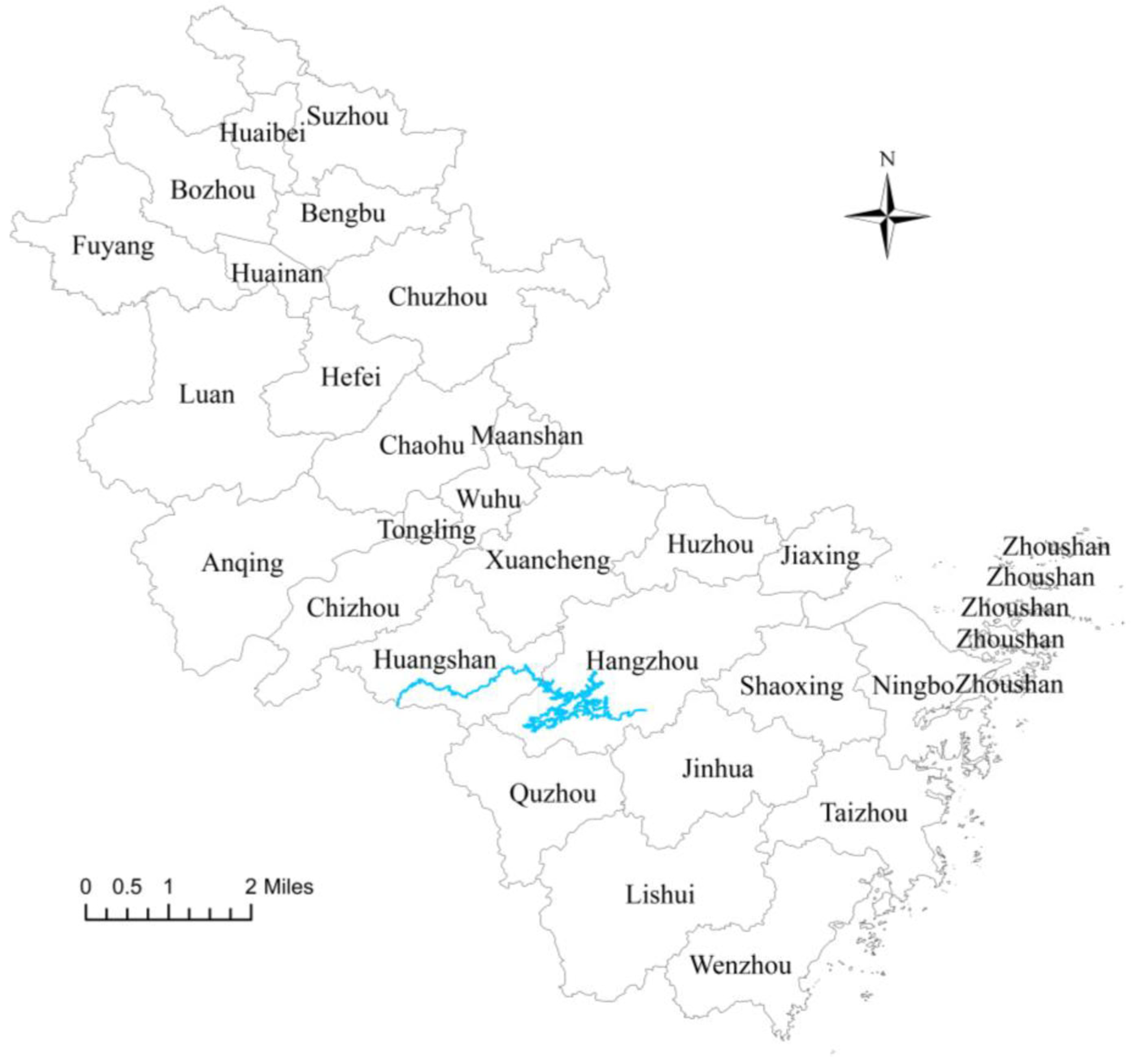
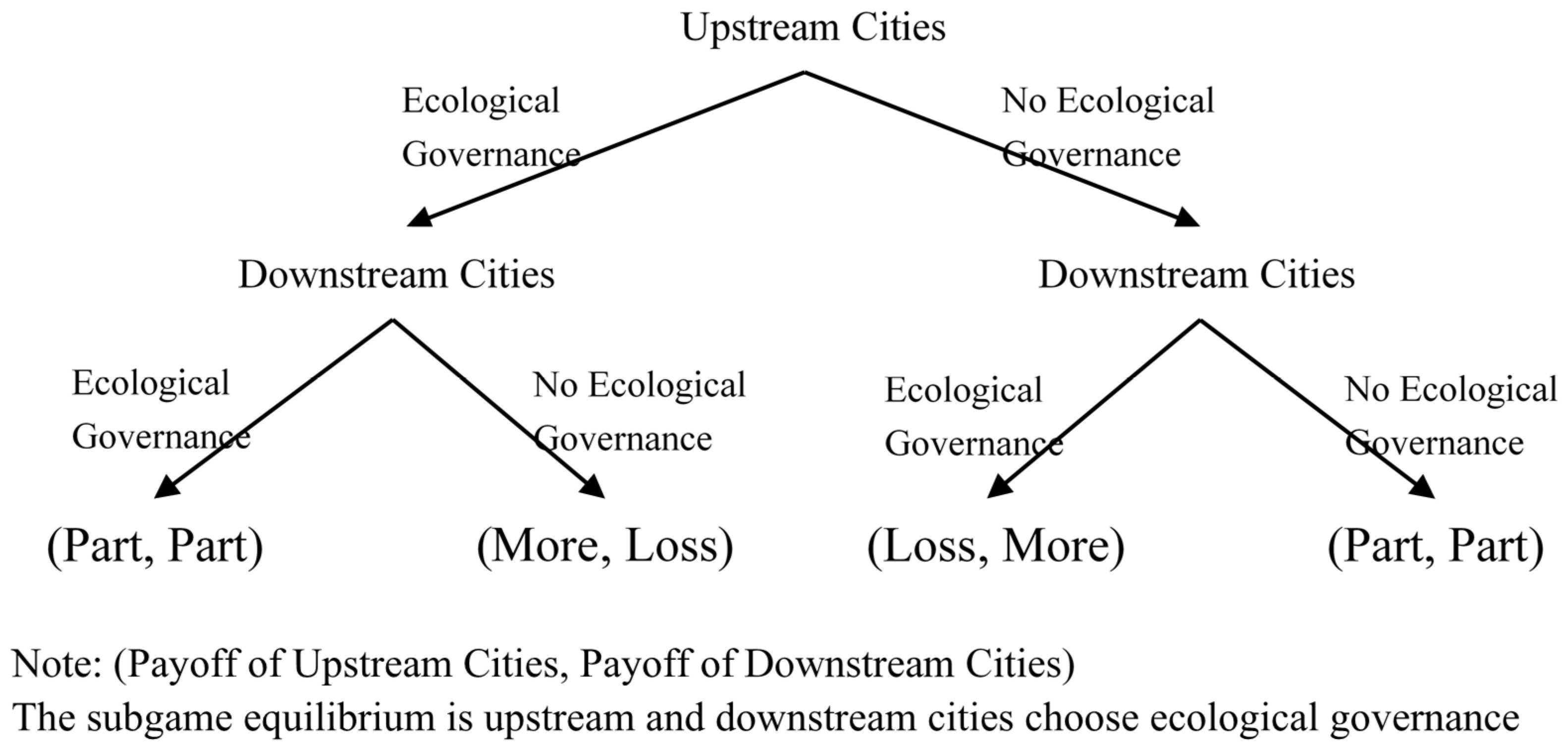
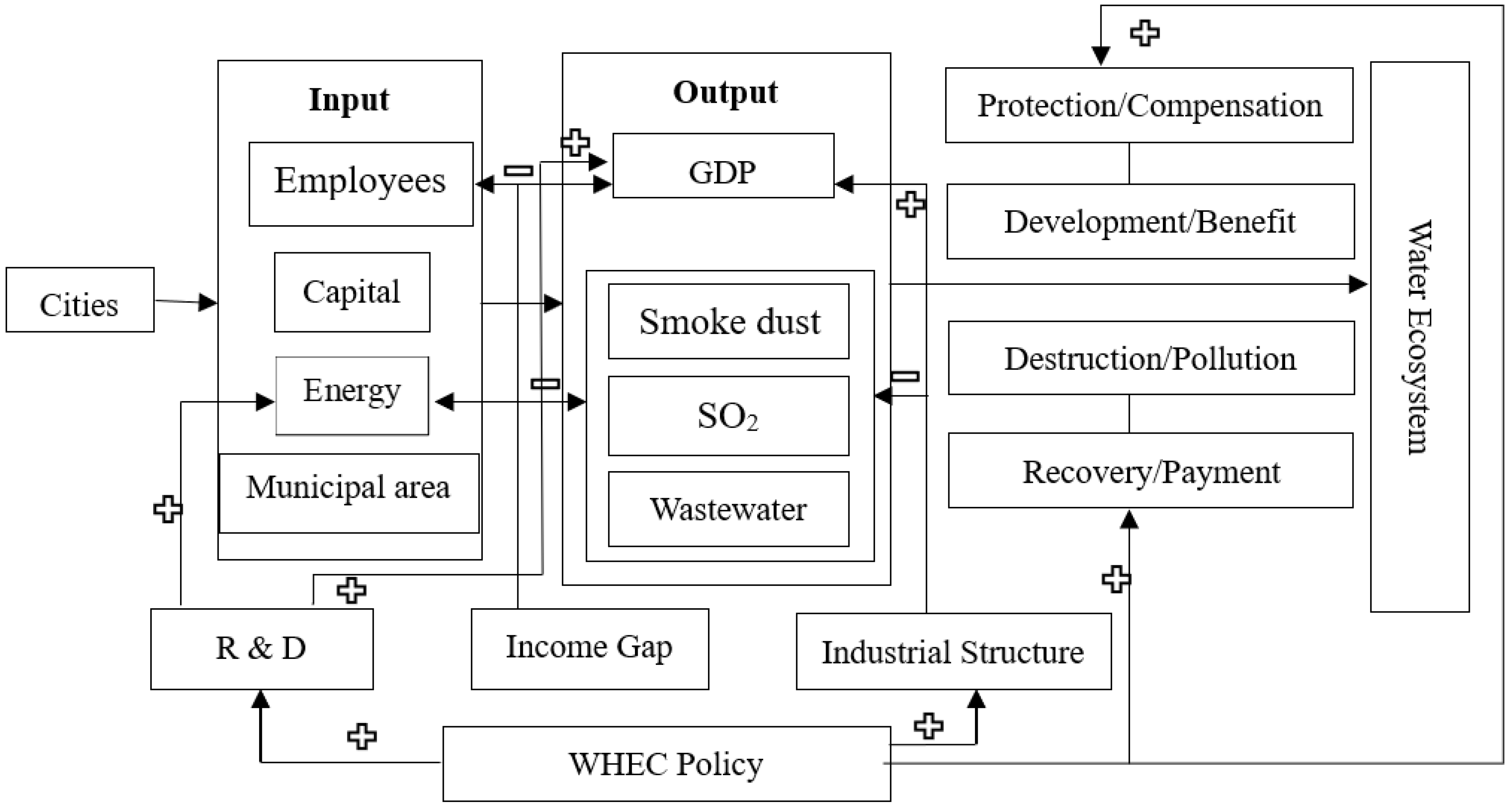

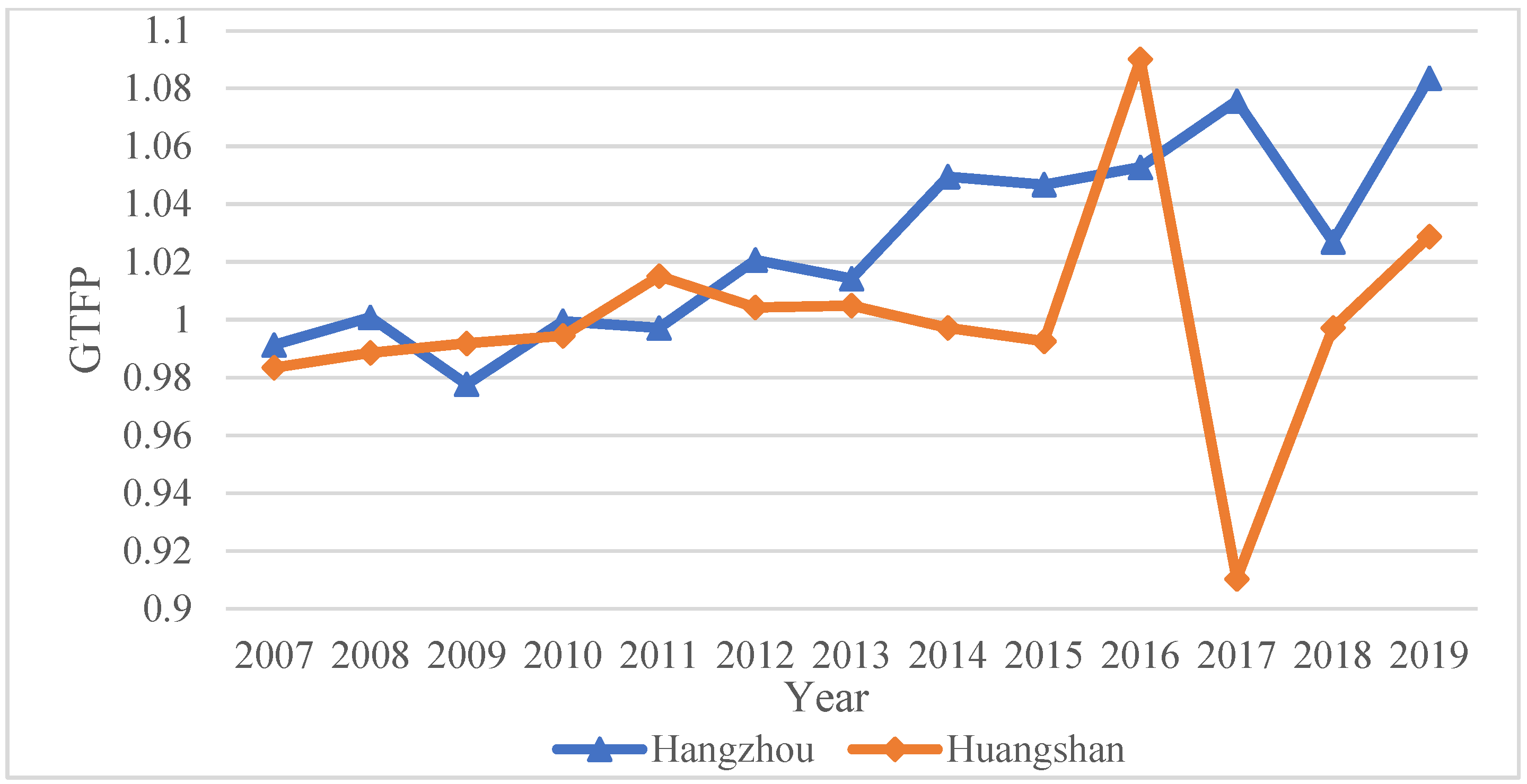
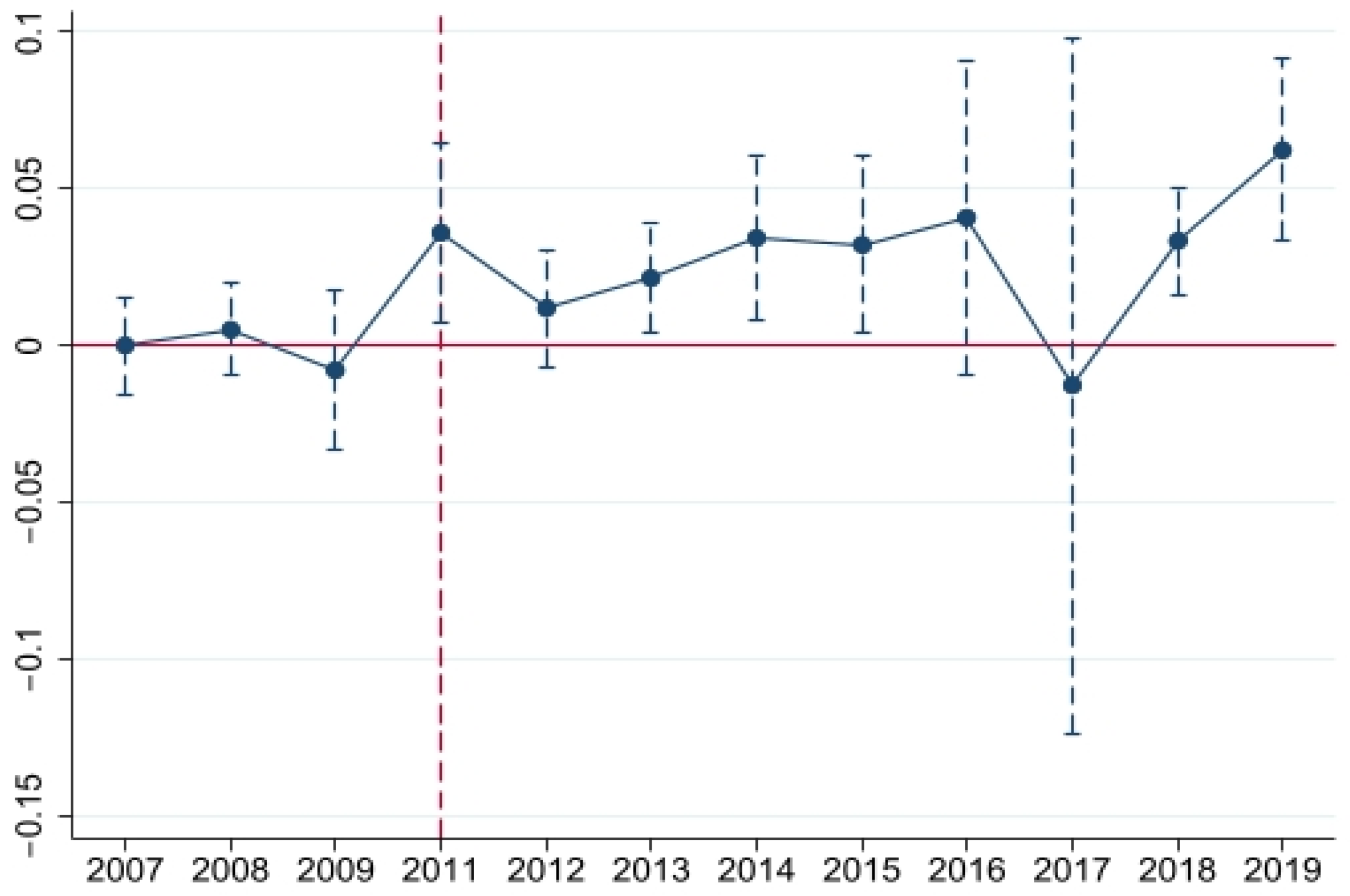
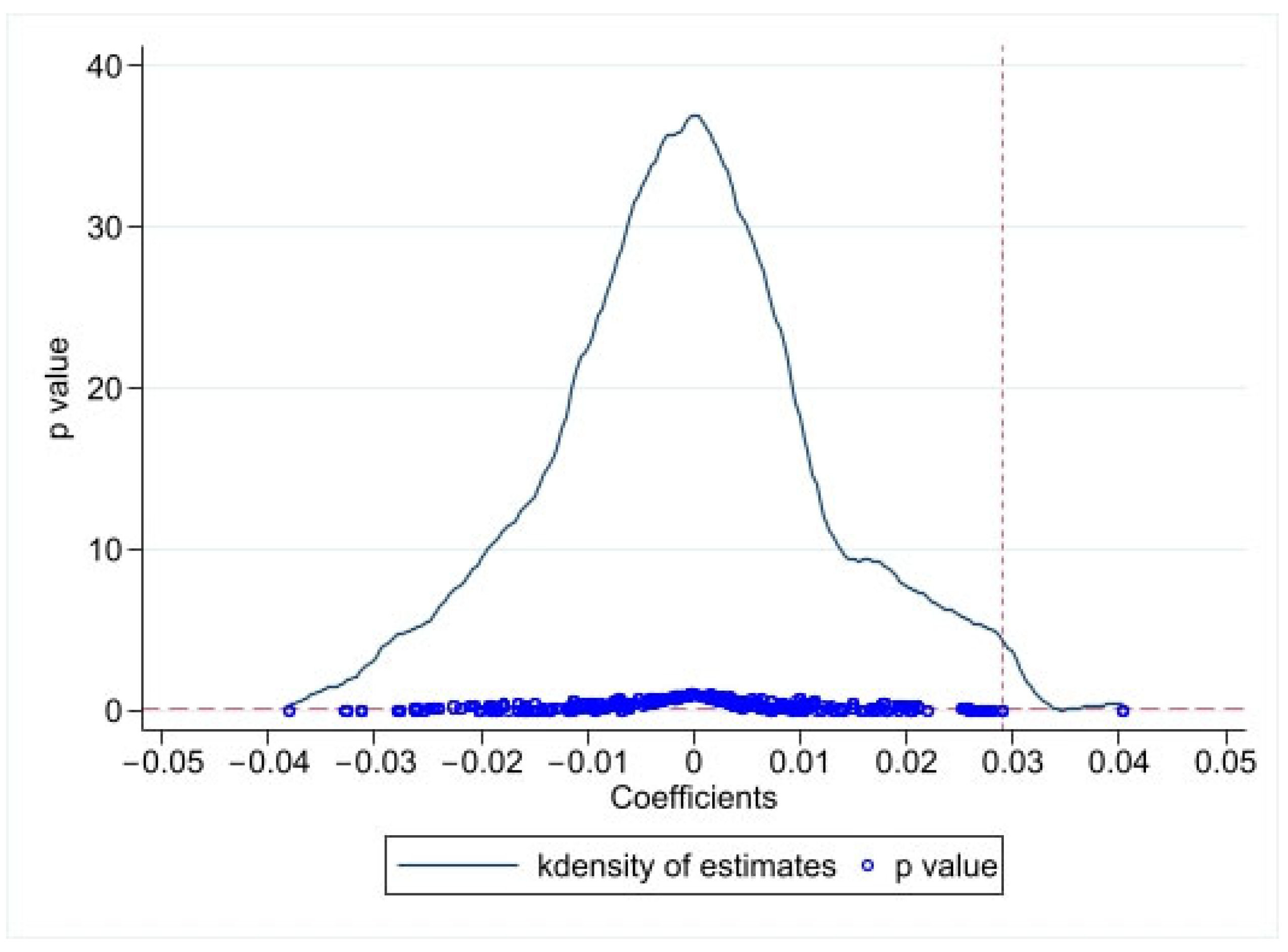
| Variable | Treated Group | Control Group | ||||||||
|---|---|---|---|---|---|---|---|---|---|---|
| N | Mean | SD | Min | Max | N | Mean | SD | Min | Max | |
| GTFP | 26 | 1.010 | 0.040 | 0.910 | 1.090 | 325 | 1 | 0.030 | 0.790 | 1.110 |
| EC | 26 | 1 | 0.020 | 0.950 | 1.070 | 325 | 1 | 0.040 | 0.720 | 1.310 |
| TC | 26 | 1.010 | 0.040 | 0.910 | 1.090 | 325 | 1 | 0.030 | 0.760 | 1.300 |
| R&D | 26 | 53.20 | 23.44 | 28.98 | 116.6 | 325 | 86.81 | 71.35 | 10.34 | 338.4 |
| IS | 26 | 0.170 | 0.110 | 0.070 | 0.390 | 325 | 0.240 | 0.200 | 0.020 | 1.080 |
| Be | 26 | 14.94 | 1.200 | 12.73 | 16.79 | 325 | 14.57 | 0.780 | 12.47 | 16.69 |
| Edu | 26 | 11.38 | 1.610 | 9.490 | 13.07 | 325 | 10.60 | 0.900 | 8.010 | 13.18 |
| Tran | 26 | 9.300 | 1.040 | 7.660 | 10.50 | 325 | 9.110 | 0.710 | 7.280 | 10.60 |
| Inter | 26 | 13.02 | 1.310 | 11.41 | 14.52 | 325 | 12.44 | 0.890 | 9.420 | 14.60 |
| Ec | 26 | 13.99 | 1.840 | 11.71 | 15.92 | 325 | 13.98 | 0.840 | 12.34 | 15.90 |
| Variables | (1) | (2) | (3) |
|---|---|---|---|
| did | 0.0264 ** | 0.0264 ** | 0.0291 ** |
| (0.0124) | (0.0126) | (0.0106) | |
| Control variable | No | No | Yes |
| Constant | 0.9917 *** | 0.9899 *** | 0.6362 ** |
| (0.0018) | (0.0053) | (0.2639) | |
| City-fixed effect | No | No | Yes |
| Year-fixed effect | No | Yes | Yes |
| N | 351 | 351 | 351 |
| R2 | 0.0213 | 0.2665 | 0.2945 |
| Variables | (1) GTFP M = R&D | (2) GTFP M = IS | (3) GTFP M = TI |
|---|---|---|---|
| did | 0.0590 *** | 0.0576 *** | 0.0483 ** |
| (0.0172) | (0.0058) | (0.0260) | |
| did*M | −0.0005 ** | −0.1832 *** | −0.4127 |
| (0.0002) | (0.0378) | (0.4508) | |
| did*25%M | 0.0576 *** | 0.0546 *** | 0.0441 |
| (0.0172) | (0.0063) | (0.0311) | |
| did*50%M | 0.0569 *** | 0.0525 *** | 0.0415 |
| (0.0172) | (0.0072) | (0.0357) | |
| did*75%M | 0.0556 *** | 0.0473 *** | 0.0395 |
| (0.0173) | (0.0104) | (0.0396) | |
| Control variable | Yes | Yes | Yes |
| City-fixed effect | Yes | Yes | Yes |
| Year-fixed effect | Yes | Yes | Yes |
| Constant | 0.5703 ** | 0.5484 ** | 0.3526 |
| (0.2579) | (0.2520) | (0.4163) | |
| N | 351 | 351 | 270 |
| R2 | 0.2979 | 0.2982 | 0.3437 |
| Variable | GTFP | |
|---|---|---|
| Anhui Province | Zhejiang Province | |
| did | 0.0183 *** | 0.0451 *** |
| (0.0054) | (0.0071) | |
| Control variable | Yes | Yes |
| City-fixed effect | Yes | Yes |
| Year-fixed effect | Yes | Yes |
| Constant | 0.4975 | 0.7007 |
| (0.3974) | (0.6385) | |
| N | 207 | 144 |
| R2 | 0.2823 | 0.4595 |
| Year | Global Moran’s I | z |
|---|---|---|
| 2007 | 0.029 ** | 1.989 |
| 2008 | 0.014 * | 1.709 |
| 2009 | 0.030 ** | 1.957 |
| 2010 | −0.037 | 0.039 |
| 2011 | −0.055 | −0.472 |
| 2012 | −0.049 | −0.296 |
| 2013 | −0.052 | −0.338 |
| 2014 | −0.018 | 0.515 |
| 2015 | 0.002 | 0.997 |
| 2016 | −0.027 | 0.275 |
| 2017 | −0.006 | 0.817 |
| 2018 | 0.205 *** | 6.224 |
| 2019 | 0.022 | 1.548 |
| Variables | (1) W = W1 | (2) W = W2 |
|---|---|---|
| did | 0.0291 *** | 0.0290 *** |
| (0.0103) | (0.0102) | |
| δ*W*GTFP | −0.1275 | −0.0736 |
| (0.1459) | (0.1330) | |
| Control variable | Yes | Yes |
| City-fixed effect | Yes | Yes |
| Year-fixed effect | Yes | Yes |
| N | 351 | 351 |
| R2 | 0.0892 | 0.0891 |
| Variables | (1) | (2) | (3) |
|---|---|---|---|
| did | 0.0253 * | 0.0248 * | 0.0310 *** |
| (0.0133) | (0.0142) | (0.0067) | |
| Control variable | No | No | Yes |
| Constant | 0.9906 *** | 1.003 *** | 0.9373 ** |
| (0.0043) | (0.0079) | (0.4229) | |
| City-fixed effect | No | No | Yes |
| Year-fixed effect | No | Yes | Yes |
| N | 141 | 141 | 141 |
| R2 | 0.0508 | 0.3908 | 0.4325 |
| Variables | (1) | (2) | (3) |
|---|---|---|---|
| did | 0.0290 ** | 0.0290 ** | 0.0290 ** |
| (0.0105) | (0.0105) | (0.0105) | |
| did1 | Yes | Yes | |
| did2 | Yes | Yes | |
| did3 | Yes | Yes | |
| Control variable | Yes | Yes | Yes |
| Constant | 0.6362 ** | 0.6362 ** | 0.6362 ** |
| (0.2639) | (0.2639) | (0.2639) | |
| City fixed effect | Yes | Yes | Yes |
| Year fixed effect | Yes | Yes | Yes |
| N | 351 | 351 | 351 |
| R2 | 0.2945 | 0.2945 | 0.2945 |
| Variables | (1) First Year | (2) Fourth Years | (3) GTFP1 | (4) GTFP2 | (5) GTFP3 |
|---|---|---|---|---|---|
| did | 0.0207 | 0.0184 | 0.0301 ** | 0.0249 *** | 0.0344 ** |
| (0.0138) | (0.0116) | (0.0116) | (0.0058) | (0.0139) | |
| Control variable | Yes | Yes | Yes | Yes | Yes |
| Constant | 0.6347 ** | 0.6311 ** | 0.4368 | 0.4371 ** | 1.0024 *** |
| (0.2598) | (0.2604) | (0.3396) | (0.4559) | (0.1993) | |
| City fixed effect | Yes | Yes | Yes | Yes | Yes |
| Year fixed effect | Yes | Yes | Yes | Yes | Yes |
| N | 351 | 351 | 351 | 351 | 351 |
| R2 | 0.2891 | 0.2873 | 0.0880 | 0.1264 | 0.2245 |
Disclaimer/Publisher’s Note: The statements, opinions and data contained in all publications are solely those of the individual author(s) and contributor(s) and not of MDPI and/or the editor(s). MDPI and/or the editor(s) disclaim responsibility for any injury to people or property resulting from any ideas, methods, instructions or products referred to in the content. |
© 2023 by the authors. Licensee MDPI, Basel, Switzerland. This article is an open access article distributed under the terms and conditions of the Creative Commons Attribution (CC BY) license (https://creativecommons.org/licenses/by/4.0/).
Share and Cite
Lin, X.; Baskaran, A.; Zhang, Y. Watershed Horizontal Ecological Compensation Policy and Green Ecological City Development: Spatial and Mechanism Assessment. Int. J. Environ. Res. Public Health 2023, 20, 2679. https://doi.org/10.3390/ijerph20032679
Lin X, Baskaran A, Zhang Y. Watershed Horizontal Ecological Compensation Policy and Green Ecological City Development: Spatial and Mechanism Assessment. International Journal of Environmental Research and Public Health. 2023; 20(3):2679. https://doi.org/10.3390/ijerph20032679
Chicago/Turabian StyleLin, Xinwen, Angathevar Baskaran, and Yajie Zhang. 2023. "Watershed Horizontal Ecological Compensation Policy and Green Ecological City Development: Spatial and Mechanism Assessment" International Journal of Environmental Research and Public Health 20, no. 3: 2679. https://doi.org/10.3390/ijerph20032679
APA StyleLin, X., Baskaran, A., & Zhang, Y. (2023). Watershed Horizontal Ecological Compensation Policy and Green Ecological City Development: Spatial and Mechanism Assessment. International Journal of Environmental Research and Public Health, 20(3), 2679. https://doi.org/10.3390/ijerph20032679







